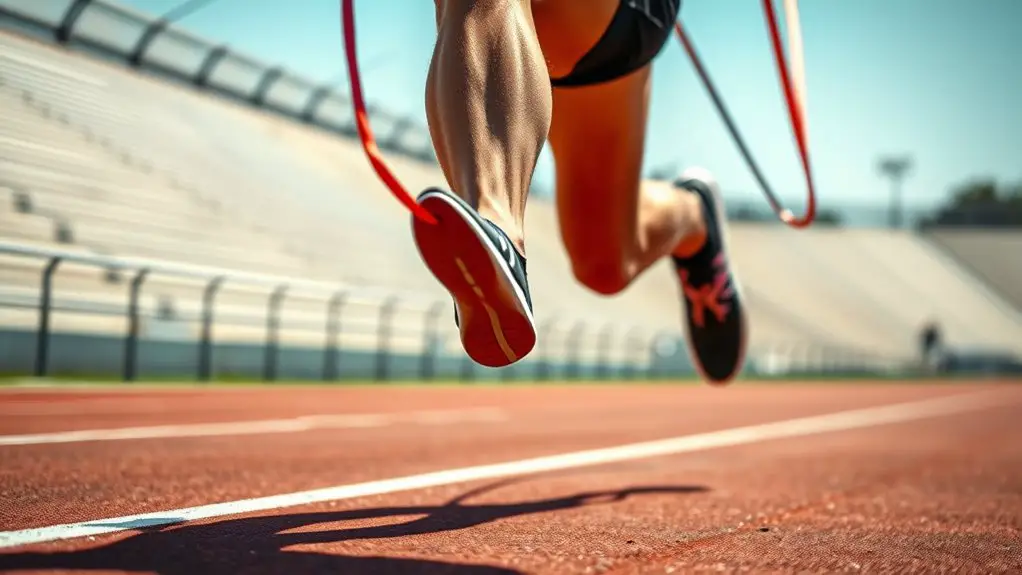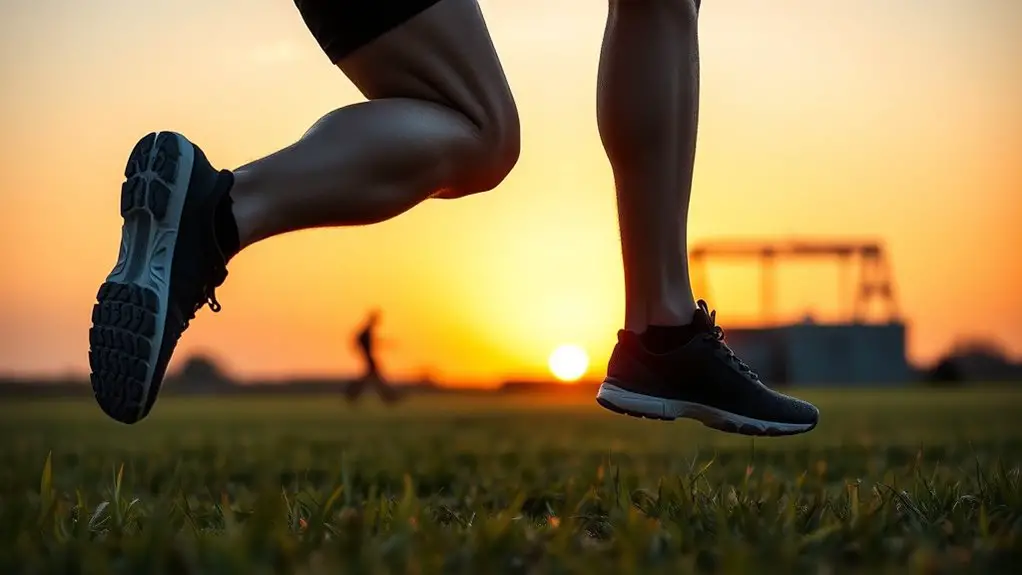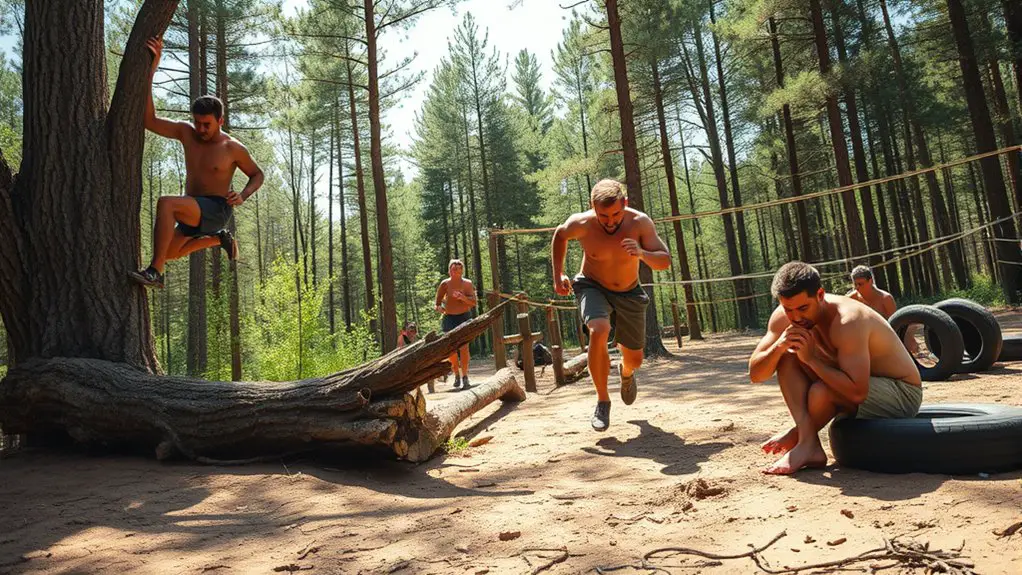To develop a faster kick, focus on resistance training that strengthens key muscle groups like your hip flexors, quadriceps, and glutes. Exercises like squats, lunges, and plyometrics can help build explosive power. Incorporating resistance bands and swim fins into your routine can also enhance your kick strength and efficiency. Remember to monitor your progress and maintain proper technique to avoid injuries. There's more to explore about crafting a balanced training program to supercharge your kicks.
Understanding the Importance of a Strong Kick
A powerful kick can be the difference between winning and losing in many sports, particularly in martial arts and swimming. Understanding kick efficiency is essential; it's not just about strength but also about how effectively you transfer energy into movement. The dynamics of propulsion come into play when you kick, influencing your speed and control.
When you master these elements, you're not just kicking harder; you're kicking smarter. Each kick should feel effortless, allowing you to glide through water or deliver a precise strike with confidence. Resistance band training enhances muscle activation and stability, which can significantly improve your kicking technique.
Think about the rhythm and timing of your kicks—these can elevate your performance considerably. By honing your technique and focusing on the propulsion dynamics, you'll release your potential and enjoy the freedom that comes with a strong kick. Ultimately, it's this balance of power and efficiency that sets you apart in your sport, pushing you closer to your goals.
Key Muscle Groups for a Powerful Kick
To achieve a powerful kick, you need to engage the right muscle groups effectively. Focusing on specific areas enhances your kick's speed and strength, giving you the freedom to glide through water effortlessly.
| Muscle Group | Key Focus |
|---|---|
| Hip Flexors | Development for lift |
| Quadriceps | Strengthening for power |
| Glutes | Activation for drive |
| Calves | Conditioning for push |
Don't overlook core stability, as it's essential for maintaining balance. Improving ankle mobility will allow for a more fluid motion, while hamstring flexibility helps in achieving a full range of motion. Overall leg integration ties these elements together, ensuring your kick is both powerful and efficient. By training these muscle groups, you'll reveal your potential and experience the true liberating feeling of a strong, fast kick. Incorporating exercises like squats and lunges into your routine can further enhance your performance and strength.
Types of Resistance Training for Swimmers
When it comes to improving your kick, resistance training can make a big difference. You'll find that both dryland exercises and aquatic resistance tools can enhance your strength and power in the water. Let's explore how these methods can benefit your training and performance. Incorporating functional strength training into your routine can help you develop the explosive power needed for a faster kick.
Dryland Exercises Benefits
Dryland exercises are essential for swimmers looking to enhance their kick speed and overall performance in the water. These dryland workouts offer resistance benefits that translate directly into improved power and efficiency in your strokes. By incorporating strength training and plyometrics, you can target the specific muscle groups used in swimming, making your kicks more explosive. You'll also build endurance, allowing you to maintain speed over longer distances. Plus, dryland exercises help reduce injury risk by strengthening supporting muscles and improving flexibility. The freedom to train anywhere means you can fit these workouts into your routine, ensuring you're always ready to hit the pool with confidence. Embrace dryland training, and watch your kick transform!
Aquatic Resistance Tools
Building on the benefits of dryland exercises, incorporating aquatic resistance tools can further amplify your kicking power in the pool. These tools help you build strength while enjoying the freedom of movement in water. Here are four effective tools to evaluate:
- Kickboards: Use them for kickboard drills to isolate your legs and focus on form.
- Aquatic Gloves: These increase resistance, engaging your arms and core while you kick.
- Resistance Bands: Attach them to a stationary point to create drag, enhancing your power.
- Fins: They help improve your kick technique and build speed, giving you that extra boost.
Incorporating Resistance Bands Into Your Routine
Incorporating resistance bands into your training routine can greatly enhance your kick strength and speed. These versatile tools offer a way to build muscle without the bulk, giving you the freedom to move more efficiently in the water. Start with basic band exercises like lateral leg lifts and standing kicks, which target your hip flexors and improve kick mechanics.
You can also experiment with resistance variations by adjusting the band's thickness or position to increase intensity. For instance, anchoring the band to a stable surface while performing flutter kicks helps simulate resistance in the water. This not only builds strength but also enhances your body awareness and control. Additionally, focusing on proper technique during these exercises ensures that you maximize explosive power and reduce injury risk.
Integrating these exercises into your regimen just a few times a week can yield noticeable improvements. So, grab some bands, release your potential, and feel the difference in your kick as you glide through the water with newfound power.
Using Swim Fins for Enhanced Strength Training
While swim fins might seem like just another accessory, they can greatly enhance your strength training in the water. By using fins, you can increase resistance levels, making your kicks more powerful and efficient. Here are some fins benefits you'll enjoy:
Swim fins are not just accessories; they significantly boost your strength training and enhance your performance in the water.
- Improved Leg Strength: The added resistance forces your muscles to work harder, building strength in your legs.
- Enhanced Technique: Fins help you focus on your kick form, promoting a more streamlined position in the water.
- Increased Speed: With stronger legs, you'll notice a significant boost in your overall swimming speed.
- Reduced Fatigue: Fins allow you to swim longer distances without tiring, enabling you to build endurance. Additionally, embracing challenges through muscular endurance training can lead to greater improvements in your swimming performance.
The Benefits of Dryland Strength Exercises
Dryland strength exercises are essential for boosting your leg strength and improving your kick mechanics. By incorporating these workouts into your routine, you'll increase both your power and endurance in the water. This foundation can set you up for a faster, more efficient kick. Additionally, focusing on arm strength development can enhance overall athletic performance, contributing to better kicking dynamics and stability.
Enhances Overall Leg Strength
Leg strength is essential for swimmers looking to enhance their kick and overall performance. Improving your leg power not only boosts your kick efficiency but also supports your entire swimming technique. Here are four key benefits of enhancing overall leg strength through dryland exercises:
- Increased Power: Stronger legs provide more force during each kick.
- Better Endurance: Enhanced leg strength helps you maintain speed over longer distances.
- Improved Stability: Strong legs support a better body position in the water.
- Injury Prevention: Building strength reduces the risk of leg injuries, keeping you in the pool longer.
Improves Kick Mechanics
Improving your kick mechanics is essential for releasing your full potential in the water, and dryland strength exercises play a crucial role in this process. By focusing on kick biomechanics, you can enhance your efficiency and fluidity while swimming. Resistance application through targeted exercises helps you develop the specific muscle groups that drive your kicks, allowing for a more powerful and streamlined motion in the water. These exercises not only train your legs but also improve your overall body coordination, ensuring that every part of your kick works in harmony. As you refine your technique through dryland training, you'll discover newfound freedom in your movements, translating into faster, more effective kicks when you hit the water.
Increases Power and Endurance
While many swimmers focus on in-water training, incorporating dryland strength exercises can considerably increase both power and endurance. By adding resistance training, you can enhance your kick efficiency and experience resistance adaptation, leading to better performance in the pool. Here are some benefits of dryland strength exercises:
- Improved Muscle Strength: Boosts the power behind each kick.
- Enhanced Stamina: Increases your endurance for longer training sessions.
- Injury Prevention: Strengthens muscles and joints, reducing the risk of injuries.
- Better Overall Performance: Translates to faster times and more efficient strokes.
Embrace dryland training, and you'll find freedom in the water with a more powerful, enduring kick.
Crafting a Balanced Resistance Training Program
To develop a faster kick, it is essential to design a balanced resistance training program that targets the key muscle groups involved in kicking. Start by identifying your program goals—whether you're aiming for explosive power, endurance, or a combination of both. Incorporate exercise variety to keep your workouts engaging and effective.
Focus on compound movements like squats and lunges to build strength in your legs, while adding plyometric exercises to enhance explosiveness. Don't forget your core; exercises like planks and Russian twists can improve stability and power transfer during kicks. Bodyweight exercises can also be integrated to enhance core stability and overall strength.
Balance is key, so make certain you also include upper body workouts to maintain overall strength. By mixing different types of resistance training—free weights, bands, or machines—you'll challenge your muscles in diverse ways, leading to greater gains. Embrace this freedom in your training, and you'll see improvements in your kicking technique and speed.
Monitoring Progress and Adjusting Workouts
As you work on developing a faster kick, monitoring your progress becomes essential for ensuring that your training remains effective and aligned with your goals. Here's how you can track your progress and make workout adjustments when needed:
- Set clear benchmarks: Establish specific performance metrics to evaluate your kick speed over time.
- Keep a training log: Record your workouts, including resistance used and number of reps, to identify trends.
- Regularly assess your performance: Use timed trials or video analysis to see improvements and areas that need work.
- Be flexible: If you notice stagnation, adjust your workouts by varying resistance or incorporating new exercises. Additionally, ensure that you are maintaining proper hydration to support optimal performance and recovery during your training sessions.
Tips for Maintaining Proper Technique During Resistance Training
Maintaining proper technique during resistance training is essential for both effectiveness and injury prevention. To keep your body safe and your workouts productive, focus on maintaining proper posture. Stand tall with your shoulders back and engage your core, ensuring your spine is aligned. This alignment allows you to generate more power while reducing strain. Core strength acts as the foundation of athletic performance, enabling better control during your lifts and movements.
Don't forget about your breathing techniques. Inhale deeply before you begin your lift, and exhale as you exert force. This rhythm not only helps with performance but also supports your body's natural movements.
Also, pay attention to your range of motion. Avoid overshooting or forcing movements, as this can lead to bad habits and potential injuries. Finally, listen to your body; if something feels off, it's okay to adjust your technique or take a break. By staying mindful, you'll develop a strong, effective kick while enjoying the freedom of movement.
Frequently Asked Questions
How Often Should I Do Resistance Training for Swimming?
When it comes to resistance training for swimming, you should aim for 2 to 3 sessions a week. This training frequency allows you to build strength while still giving your body enough recovery periods to avoid burnout. Listen to your body; if you're feeling fatigued, don't hesitate to take an extra rest day. Finding that balance is key to enjoying your training and seeing improvements without feeling restricted or overwhelmed.
Can Resistance Training Improve My Overall Swimming Speed?
Ever wonder if you could swim faster with just a few tweaks? Yes, resistance training can definitely improve your overall swimming speed. By enhancing your kick efficiency through various training techniques, you'll develop stronger legs and better propulsion in the water. With consistent effort, you'll feel a newfound freedom in your strokes, allowing you to glide through the water with ease. So, why not embrace the challenge and elevate your swimming game?
Should I Focus on Endurance or Strength Training for Kicks?
When deciding whether to focus on endurance or strength training for your kicks, consider your goals. Endurance benefits can enhance your stamina, allowing you to maintain speed over longer distances. On the other hand, strength techniques can boost your power, leading to quicker, more explosive kicks. Ideally, a balanced approach incorporating both aspects will give you the freedom to excel in various swimming conditions and improve your overall performance. Choose what feels right for you!
What Are Common Mistakes in Resistance Training for Swimmers?
So, you think you can just haul weights around and call it resistance training? Well, hold onto your goggles! Common mistakes include improper form—because who needs a healthy back, right? And let's not forget the lack of specificity; it's not like you're training for a specific swim event or anything. Embrace freedom in your training but remember, doing it wrong won't set you free. Focus on technique and purpose for real gains!
How Long Until I See Results From Resistance Training?
When you start resistance training, the progress timeline can vary notably. It often depends on individual factors like your current fitness level, consistency, and training intensity. Generally, you might notice some improvements within a few weeks, but real changes could take a couple of months. Stay patient and focused on your goals—everyone's journey is unique, and with dedication, you'll experience that sense of freedom and strength you're aiming for.




